
KonTActs User Guide
KonTActs is a desktop app designed for CS2030S Teaching Assistants (TAs) who work at the National University of Singapore, School of Computing.
KonTActs streamlines contact management, helping you keep track of your students' contact, attendance and assignment information more effectively compared to traditional GUI apps.
KonTActs' main features include:
- Attendance tracking: Track student's weekly attendance.
- Assignment tracking: Add and manage student's assignment and grades.
- Contact detail storing: Store and manage student's contact information
- Quick access to GitHub: Quickly access a student's GitHub repository.
KonTActs optimization features:
- Fast typist: Provides a Command Line Interface (CLI) for navigation alongside a Graphical User Interface (GUI).
- Shortcut commands: Shortcut commands to boost productivity
- Terminal-like: Easily access previous commands
Quick start
To get started,
Ensure you have Java
17or above installed on your computer. Refer here for the specific version.Download the latest
.jarfile from here.Copy the file to your chosen home folder for KonTActs.
Open a command terminal,
cdinto home folder you put the jar file in, and enterjava -jar kontacts.jarto run the application.Once the application starts, type
view name/Alex Yeohinto the command box as shown in the picture below.An interface similar to the one below should appear in a few seconds. Note how the app contains some sample data.
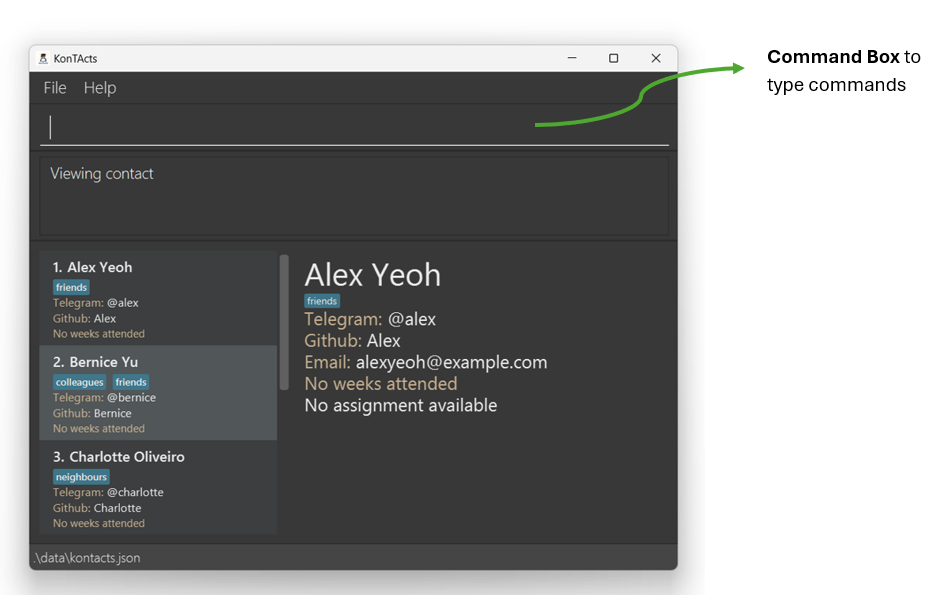
Type the command in the command box and press Enter to execute it. e.g. typing
helpand pressing Enter will open the help window.
Examples of commands you can try:list: Lists all contacts.mark name/Alex Yeoh week/0: MarksAlex Yeohattendance in KonTActs.delete name/Bernice Yu: DeletesBernice Yufrom KonTActs.addGrade name/Alex Yeoh assignment/Ex01 score/9: Assigns and addsEx01with a score of 9 toAlex Yeoh.The GUI should now look something like this.
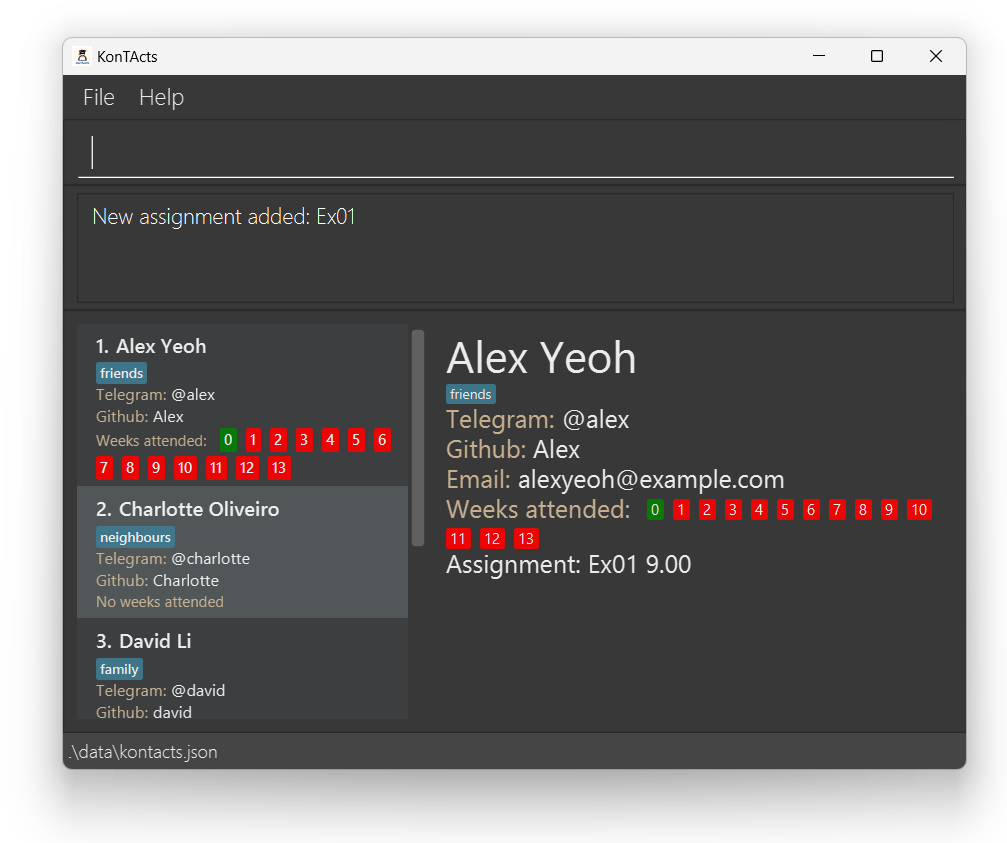
clear: Deletes all contacts. THIS IS AN IRREVERSIBLE ACTION.
- Refer to the Features below for details of each command.
Summary of commands
| Action | Format, Examples |
|---|---|
| Add | add name/NAME email/EMAIL telegram/TELEGRAM [tag/TAG]… github/GITHUB e.g., add name/James Ho email/jamesho@example.com telegram/@James tag/friend tag/colleague github/james-cool |
| Clear | clear This is an IRREVERSIBLE action! |
| Delete | delete name/NAMEe.g., delete name/James |
| Edit | edit INDEX [name/NAME] [email/EMAIL] [telegram/TELEGRAM] [tag/TAG]… [github/GITHUB]e.g., edit 2 name/James Lee email/jameslee@example.com |
| Find | find KEYWORD [MORE_KEYWORDS]e.g., find James Jake |
| Filter | filter tag/TAG [tag/MORE_TAG]…e.g., filter tag/friends tag/family |
| List | list |
| Help | help |
| View | view [name/NAME] e.g., view name/John Doe |
| Github | github name/NAME e.g., github name/Harry |
| Mark | mark name/NAME week/WEEK_NUMBER e.g. mark name/John Doe week/1 |
| Unmark | unmark name/NAME week/WEEK_NUMBER e.g. unmark name/John Doe week/1 |
| Sort | sort FIELD order/ORDER e.g. sort name order/asc |
| Import | import path/CSV_FILE_PATH e.g import path/user/data/xxx.csv |
| Export | export path/DESIRED_FILE_DESTINATION e.g export path/user/data/xxx.csv |
| Command History | ↑ and ↓ |
| Add grade | addGrade name/NAME assignment/ASSIGNMENT_NAME score/SCORE e.g. addGrade n/JohnDoe assignment/Ex01 score/5 |
| Remove grade | removeGrade name/NAME assignment/ASSIGNMENT_NAME e.g. removeGrade name/John Doe assignment/Ex01 |
Parameter shortcuts
All parameters in KonTActs come equipped with their equivalent shortcuts.
| Parameter | Shortcut |
|---|---|
name/ | n/ |
email/ | e/ |
tag/ | t/ |
assignment/ | a/ |
score/ | s/ |
telegram/ | tele/ |
github/ | g/ |
week/ | w/ |
order/ | o/ |
path/ | p/ |
All commands supports shortcut parameters as long as they require the parameter.
This is illustrated in the examples of the individual commands.
Command shortcuts
Most commands in KonTActs come equipped with their equivalent shortcuts.
| Command | Shortcut |
|---|---|
mark | m |
unmark | um |
import | im |
export | ex |
find | fd |
filter | f |
view | v |
addGrade | ag |
removeGrade | rg |
delete | rm |
edit | e |
gitHub | git |
Features
Notes about the command format:
Words in
UPPER_CASEare the parameters supplied by you.
e.g.add name/NAME,NAMEis a parameter which can be used asadd name/John Doe.Items in square brackets are optional.
e.gname/NAME [tag/TAG]can be used asname/John Doe tag/friendor asname/John Doe.Items with
… after them can be used multiple times including zero times.
e.g.[tag/TAG]…can be used as(i.e. 0 times),tag/friend,tag/friend tag/familyetc.Parameters can be in any order.
e.g. if the command specifiesname/NAME telegram/TELEGRAM,telegram/TELEGRAM name/NAMEis also acceptable.Extra parameters for commands that do not take in parameters (such as
help,list,exitandclear) will be ignored.
e.g. if the command specifieshelp 123, it will be interpreted ashelp.Extra parameters for commands that do not have said parameters in their command format will be treated as input for the previous parameter.
e.g. if the command input isdelete name/John tag/student,John tag/studentwill be considered as the NAME input.If you are using a PDF version of this document, be careful when copying and pasting commands that span multiple lines as space characters surrounding line-breaks may be omitted when copied over to the application.
Viewing help : help
The help command opens the help window that shows the link to this user guide. The window adds access to copy the url to the clipboard or directly launch this user guide from the browser.
A compact reference guide is also provided for quick reference.
Format: help
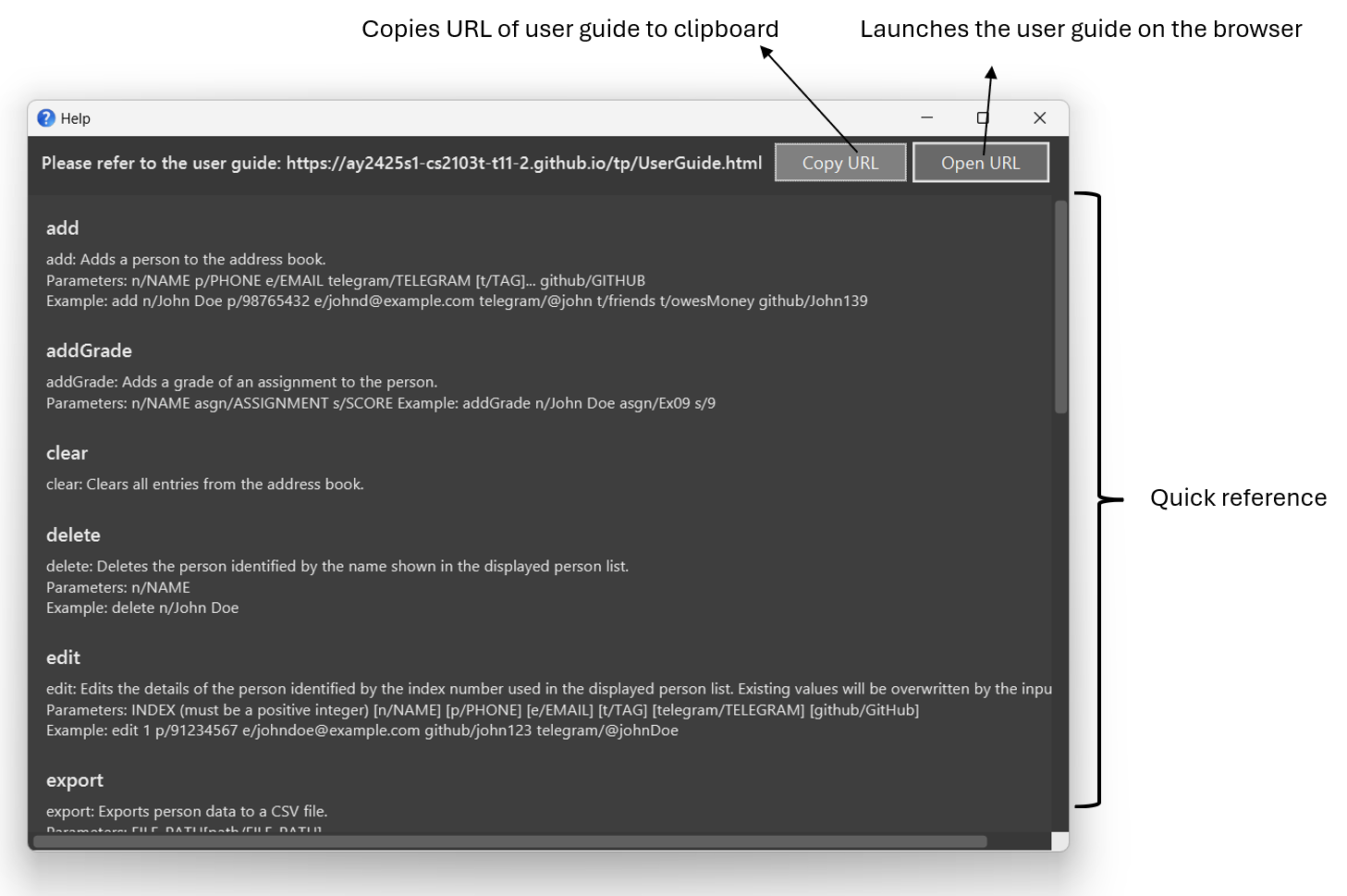
Adding a person: add
Adds a person's contact detail to KonTActs.
Format: add name/NAME email/EMAIL telegram/TELEGRAM [tag/TAG]… github/GITHUB
Shortcut: add n/NAME e/EMAIL tele/TELEGRAM [t/TAG]… g/GITHUB
Name restrictions
- Names should only contain English alphanumeric characters and whitespaces only. Special characters are not allowed.
- Names should be unique. Duplicate names cannot exist in the same database. Please refer to the FAQ on this issue.
- A name is considered unique if no other name consists of the exact same characters in the same order, case-insensitive. Whitespaces at the start and end of the name will be removed.
Eg. n/John or name/John
Email restrictions
Emails should be of the format local-part@domain and adhere to the following constraints:
local-partshould only contain English alphanumeric characters and+,_,.,-. Thelocal-partname:- may not start or end with any special characters.
- may not have any consecutive special characters.
- This is followed by an
@and then adomainname. The domain name is made up of domain labels separated by periods. Thedomain namemust:- end with a domain label at least 2 characters long.
- have each domain label start and end with English alphanumeric characters.
- have each domain label consist of English alphanumeric characters, separated only by hyphens, if any.
Eg. e/john@abc.com or email/john@abc.com
A person can have any number of tags (including 0).
Tag restrictions
- Tags must be a single word containing only English alphanumeric characters (no spaces or special symbols are allowed).
- To specify multiple tags, separate each tag parameter with a space.
Eg. t/friend t/family
Telegram username restrictions
- Usernames must start with an
@, and can only contain underscores (_) and English alphanumeric characters.
GitHub username restrictions
- Length of username must be between 1 and 39 characters.
- Can contain only English alphanumeric characters and hyphens ('-').
- Hyphens cannot appear at the start or end, nor consecutively within the username.
Valid examples
user123, user-name, username456
Invalid examples
very-mega-ultra-super-duper-long-username, -username, username-, user--name, username_with_special$chars
Examples:
add name/John Doe email/johnd@example.com telegram/@john github/swag-john33adds John Doe's contact details with no tags.add n/Betsy Crowe t/student e/betsycrowe@example.com tele/@Betsy t/Smart g/betsy-29uses shortcut parameters to add Betsy Crowe's contact details with a student and Smart tag.
Listing all persons : list
Displays all persons in KonTActs.
Format: list
Editing a person : edit
Edits an existing person detail in KonTActs.
Format: edit INDEX [name/NAME] [email/EMAIL] [telegram/TELEGRAM] [tag/TAG]… [github/GITHUB]
Shortcut: e INDEX [n/NAME] [e/EMAIL] [tele/TELEGRAM] [t/TAG]… [g/GITHUB]
- Edits the person at the specified
INDEX. The index refers to the index number shown in the displayed person list. The index must be a positive integer 1, 2, 3, … - At least one of the optional fields must be provided.
- Existing values will be updated to the input values.
- When editing tags, the existing tags of the person will be removed i.e adding of tags is not cumulative.
- You can remove all the person’s tags by typing
t/without specifying any tags after it.
Examples:
edit 1 email/johndoe@example.comEdits the email address of the 1st person to bejohndoe@example.comrespectively.edit 2 n/Betsy Crower t/Edits the name of the 2nd person to beBetsy Crowerand clears all existing tags. It uses shortcut parameters.edit 1 github/cool-james12 name/JamesEdits the name of the 1st person toJamesand github username tocool-james12.e 2 tele/@Mary n/MaryEdits the name of the 2nd person toMaryand telegram ID to@Mary. It uses shortcut command and parameters.
Finding persons by name: find
Find all persons whose names contains any of the given keywords.
Format: find KEYWORD [MORE_KEYWORDS]
Shortcut: fd KEYWORD [MORE_KEYWORDS]
- The search is case-insensitive. e.g
hanswill matchHans. - The order of the keywords does not matter. e.g.
Hans Bowill matchBo Hans. - Only the name is searched.
- Only full words will be matched e.g.
Hanwill not matchHans. - Persons matching at least one keyword will be returned (i.e.
ORsearch). e.g.Hans Bowill returnHans Gruber,Bo Yang.
Examples:
fd JohnreturnsjohnandJohn Doeusing the shortcut command.find alex charlottereturnsAlex Yeoh,Charlotte.
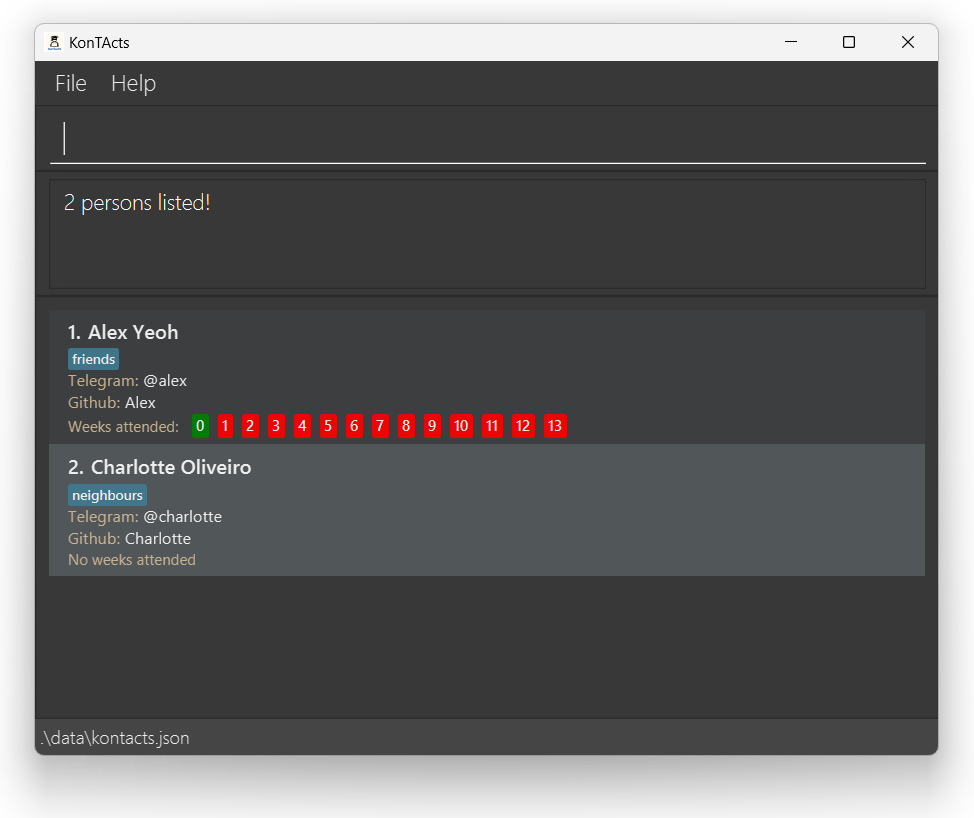
Filtering persons by tag: filter
Finds persons whose names contain any of the given tag keywords.
Format: filter tag/TAG [tag/MORE_TAG]...
Shortcut: f t/TAG [t/MORE_TAG]...
- The search is case-insensitive. e.g
friendswill matchFriends - At least one tag must be provided.
- The order of the keywords does not matter. e.g.
t/friends t/familywill matcht/family t/friends. - Only the tags are searched.
- Only full tag names will be matched. e.g.
friendwill not matchfriends. - Persons matching at least one keyword will be returned (i.e.
ORsearch). e.g.t/friends t/familywill return any contact tagged withfriendorfamily.
Examples:
f t/homiesreturns any contact tagged withhomies. It uses the shortcut command and parameter.filter tag/friendsreturns any contact tagged withfriends.
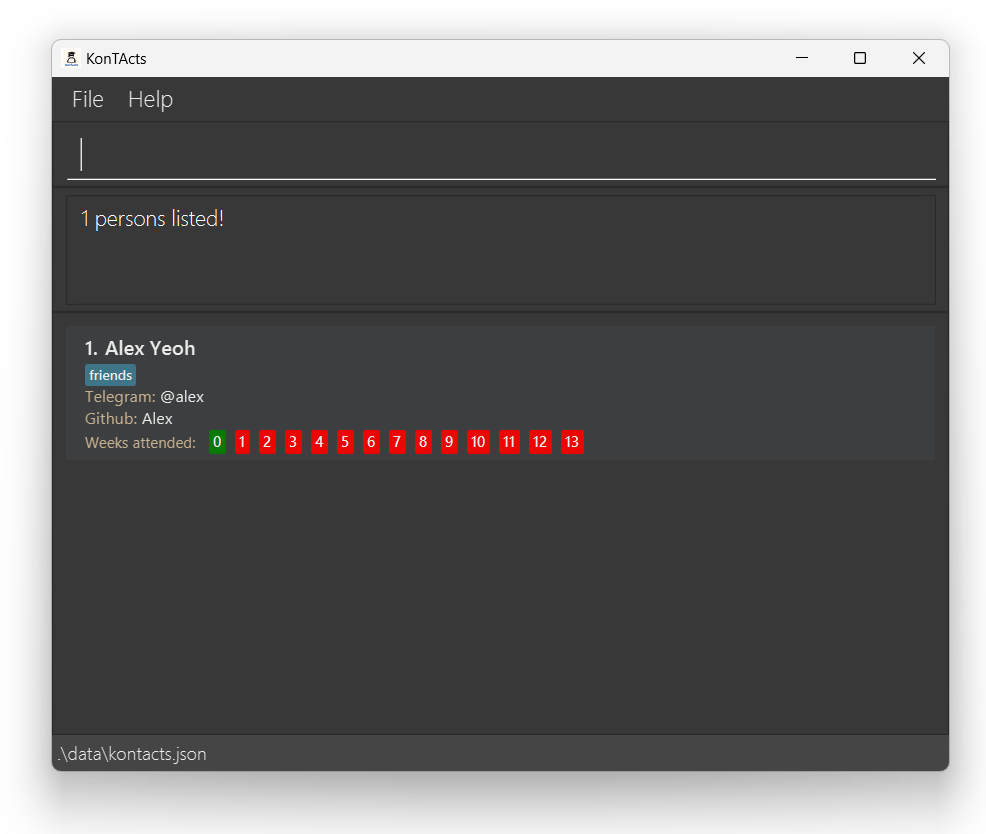
Deleting a person : delete
Deletes the specified person from KonTActs.
Format: delete name/NAME
Shortcut: rm n/NAME
- Deletes the person with the specified name.
- The name refers to the full name of the person shown in KonTActs.
- If a person matches the name but is not shown in the list, it will not be deleted.
Examples:
listfollowed byrm n/Betsydeletes the person with the nameBetsy. It uses the shortcut command and parameter.find Betsyfollowed bydelete n/Alexwill not delete the person namedAlexasAlexdoes not appear in the filtered list.delete name/Betsydeletes the person namedBetsyif it is shown on the filtered list.
Launching GitHub repository : github
Launches GitHub repository of the specified person on the browser from KonTActs.
Format: github name/NAME
Shortcut: git n/NAME
Browser security restrictions
KonTActs will attempt to open GitHub in your default browser. Please note that some browser security settings or pop-up blockers may prevent this. Please ensure that your browser allows new tabs or windows to be open from external applications before using the command.
- Launches the GitHub repository of the specified person.
- Person specified needs to have a GitHub username assigned in KonTActs.
- The name refers to the full name of the person shown in KonTActs.
Examples:
git n/Jameslaunches the GitHub repository of the person namedJames, using the GitHub username assigned toJames. It uses the shortcut command.github name/Harrylaunches the GitHub repository of the person namedHarry, using the GitHub username assigned toHarry.
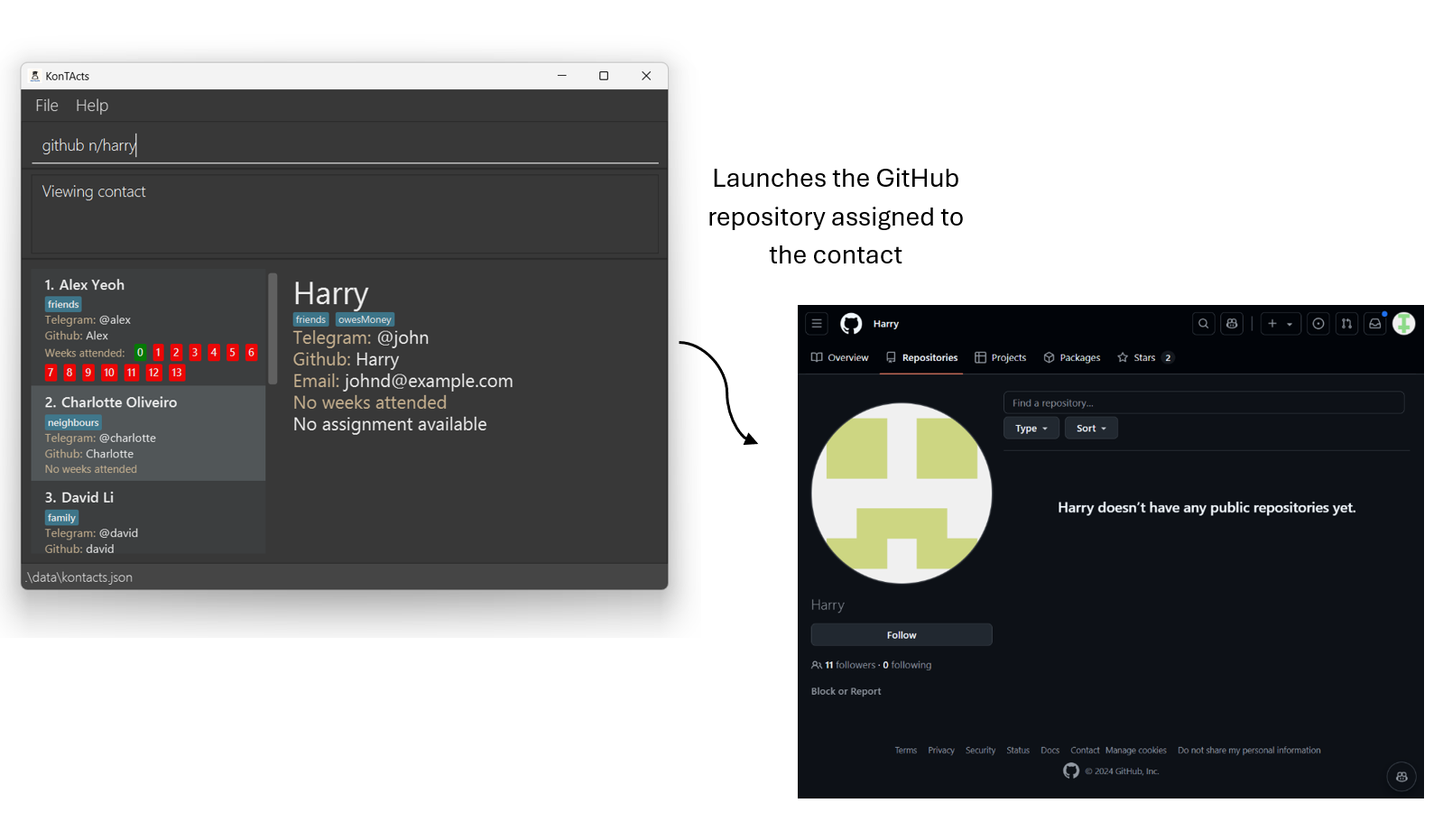
Viewing a contact's full details : view
Opens a window at the side with the full details of the specified person from KonTActs.
Format: view [name/NAME]
Shortcut: v [n/NAME]
- View the full details of the contact you specify.
NAMErefers to the full name of the person shown in KonTActs.- Calling
viewwithout any name parameter closes any windows previously opened byview. - Deleting or editing name of the current contact opened by
viewclosesview.
Examples:
view name/Alex Yeohopens a window at the side showing the full details of the person namedAlex Yeoh.
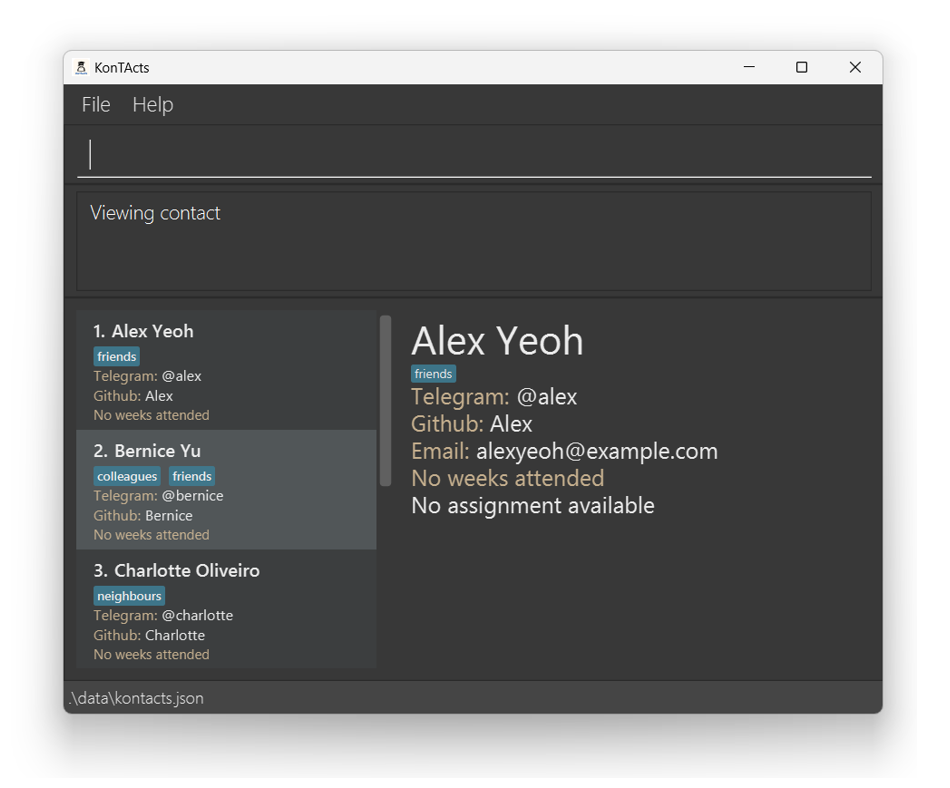
- Calling
v n/John Doefollowed byviewcloses the window showing the full contact details ofJohn Doe. It uses the shortcut command and parameter.
Marking a student as present : mark
Marks a student as present for a particular week.
Format: mark name/NAME week/WEEK_NUMBER
Shortcut: m n/NAME w/WEEK_NUMBER
- Marks the particular student as present in that week.
- The full name and week number is compulsory.
- The name is case-sensitive.
- The range of the WEEK_NUMBER is between 0 and 13, both inclusive. Rationale being there are 14 weeks per semester.
Examples:
mark name/Alex Yeoh week/0marks the student namedAlex Yeohas present for week 0.
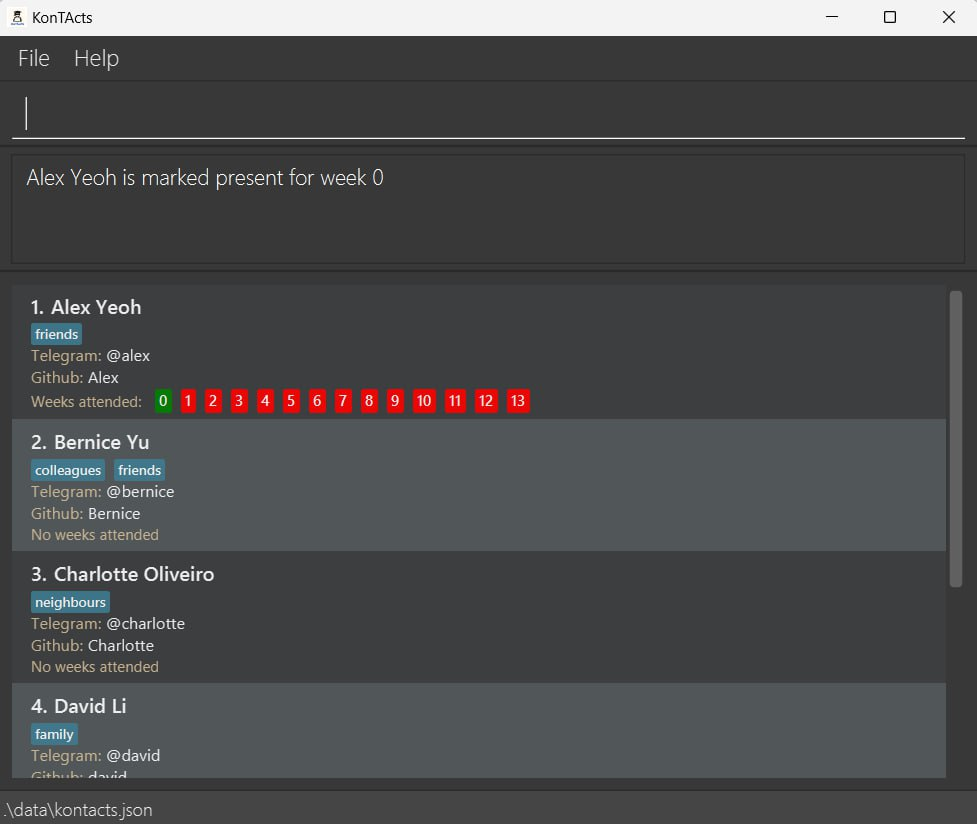
m n/Harry w/3marks the student namedHarryas present for week 3. It uses the shortcut command and parameter.
Unmarking a student as present : unmark
Unmarks a student as present for a particular week.
Format: unmark n/NAME w/WEEK_NUMBER
Shortcut: um n/NAME w/WEEK_NUMBER
- Unmarks the particular student as present in that week.
- The full name and week number is compulsory.
- The name is case-sensitive.
- The range of the WEEK_NUMBER is between 0 and 13, both inclusive. Rationale being there are 14 weeks per semester.
Examples:
unmark name/Alex Yeoh week/0marks the student namedAlex Yeohas absent for week 0.
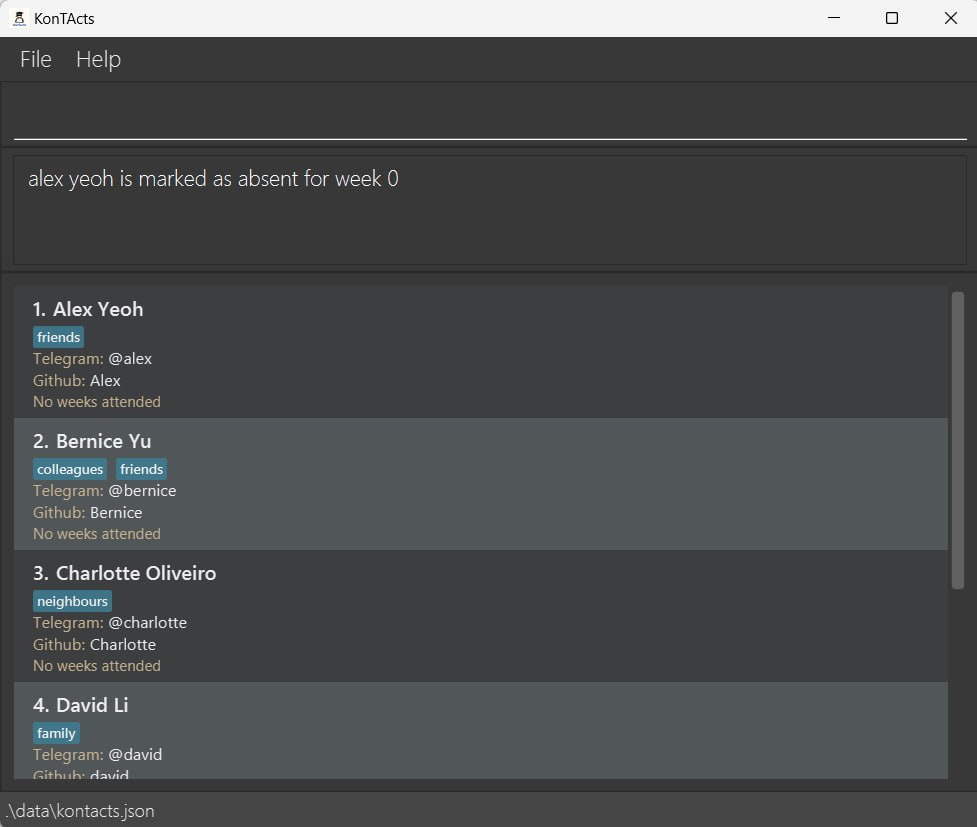
um n/Harry w/3marks the student namedHarryas absent for week 3. It uses the shortcut command and parameter.
Sorting the displayed list : sort
Sorts the displayed list based on the given field and order.
sort FIELD order/ORDER Reset Format: sort reset
Order of contact details can be reset to default by calling sort reset.
FIELDthat can be sorted by:github,name,telegram.ORDERthat is accepted:asc,desc.- The sort order persists between commands.
- The sort order will reset when
sort resetcommand is given. - The sorting is case-insensitive: upper and lower case are treated as the same values.
- The sorting will be done based on the lexicographical order of the field, regardless of text or numbers.
Examples:
sort name order/descwill sort the displayed list based on their name in ascending order.
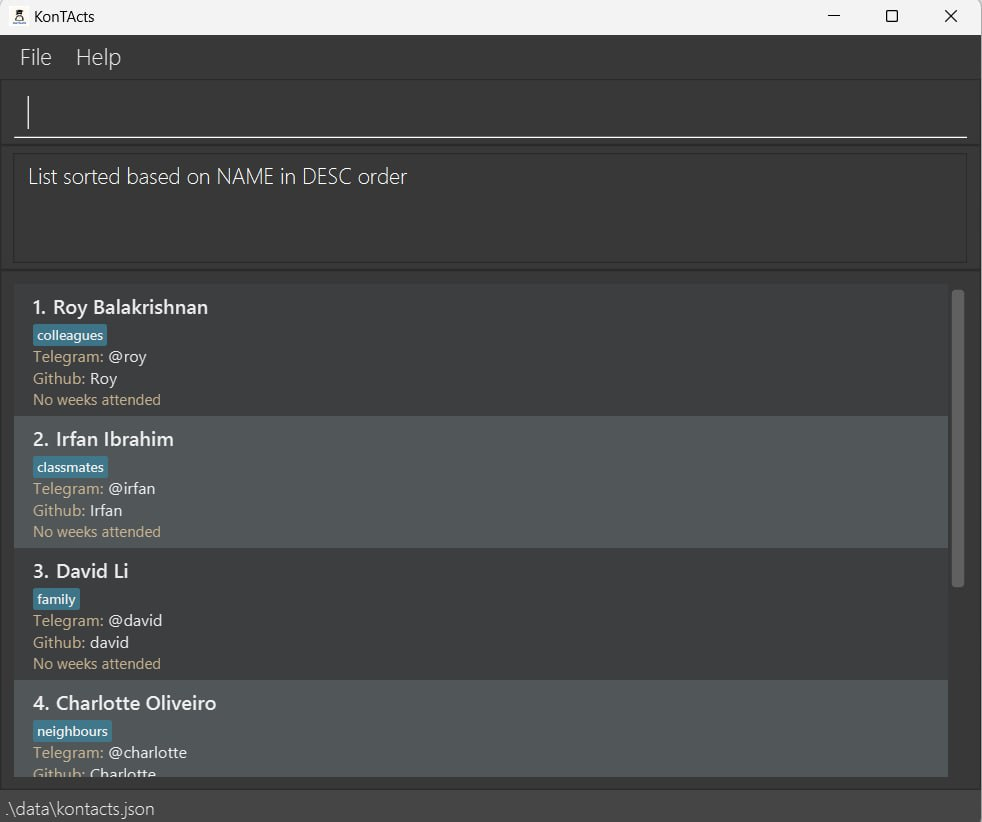
sort resetwill reset the displayed list to its default order.
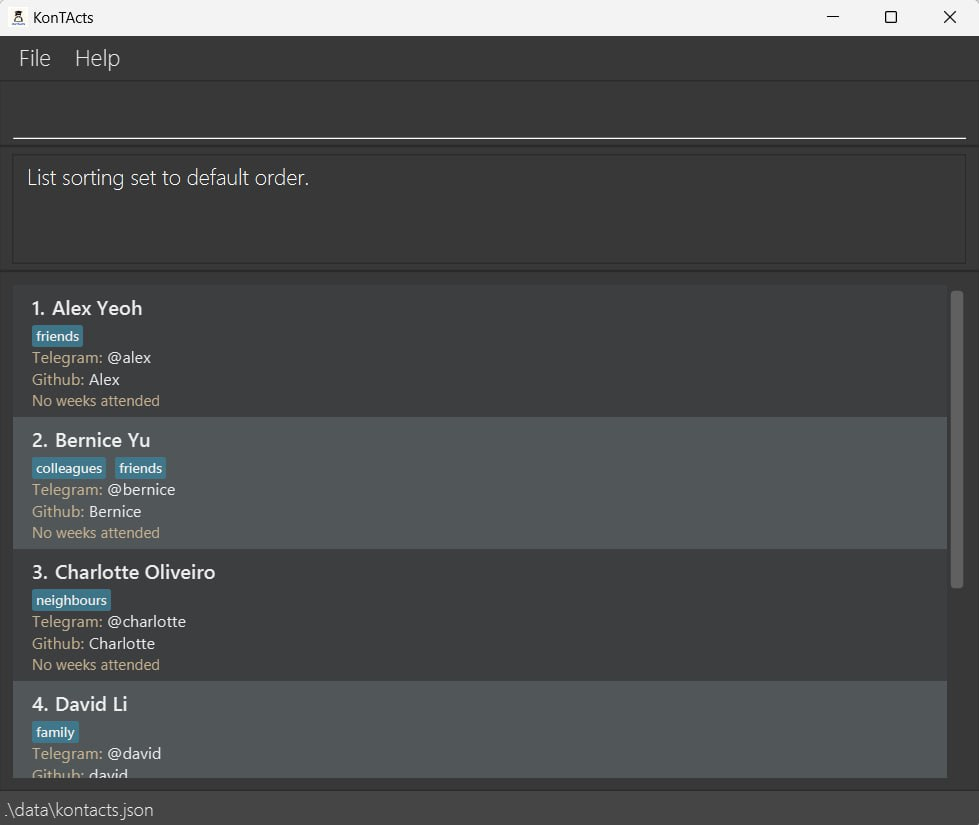
Clearing all entries : clear
Clears all entries from KonTActs.
This action is IRREVERSIBLE and it cannot be undone! You would lose all the contacts if they are not exported!
Format: clear
Importing data from CSV file : import
Imports contacts based on CSV file.
Format: import path/CSV_FILE_PATH
Shortcut: im p/CSV_FILE_PATH
- File path can be relative or absolute, but must end with ".csv".
- If using relative path, you may use ".." to move up one directory level (you may refer to example below).
- Although the ~ symbol is commonly used as home, it will not be the case when using export. Please use the full home path instead.
- Importing a file will delete ALL existing contacts before adding the contacts from the file.
Examples:
import path/data/group12.csvwill import the contacts found from the CSV (group12.csv from relative path given)- Alternatively,
im p/data/group12.csvwill do the exact same. It uses the shortcut command and parameter. import path//data/group12.csvwill import the contacts at the ABSOLUTE path given. (Absolute paths specify the exact location in the file system, starting from the root directory, so the file group12.csv at the /data directory will be imported regardless of where the program is run.)import path/../data/group12.csvwill import contacts from the CSV file (group12.csv) at the relative path. It moves up one level from the current directory and then navigates to data folder, and imports the CSV file named "group12.csv".
CSV file formatting:
The CSV file must have header with the exact required order
{"Name", "Email", "Telegram", "Tags", "Github", "Assignments", "WeeksPresent"}(Case-insensitive).The CSV file must contain information about at least 1 person.
The data fields for Name, Email, Telegram, GitHub is compulsory.
- Do note that each of these field have their own restrictions. These are defined in the (add command)
- Do note that @ is a special character in Excel formula. Hence, if editing in Excel, please input "'@TELEGRAM" instead of "@TELEGRAM". Please refer to known issues for more details.
Tags format: enclose tag in square brackets ("[tag]"). If a person has multiple tags, separate the tags within the same entry with commas. (e.g."[tag1],[tag2],[tag3].....")
- Duplicate tags will be ignored. (e.g."[Group1],[Group1]" will be treated as "[Group1]")
- This field can be empty (will be treated as no tags for specific person).
Assignment format: Assignment name and assignment score should be separated with "|" (e.g. Ex01|10). If multiple assignments are present for a person, separate them within the same entry using commas. (e.g. Ex01|9, Ex02|5)
- If an assignment name appears twice, the later instance will be used (e.g. Ex01|10, Ex01|5 will cause KonTActs to record 5 marks for Assignment Ex01).
- This field can be empty (will be treated as no assignments for specified person).
WeeksPresent format: Each integer represents a specific week, with each week separated by a comma. (e.g. 1,2,3,4).
- Duplicate weeks will be ignored (e.g. 1,2,3,4,1 will be treated as 1,2,3,4).
- This field can be empty (will be treated as no weeks attended for specific person).
Example of acceptable CSV file:
"Name","Email","Telegram","Tags","Github","Assignments","WeeksPresent"
"Alex Yeoh","alexyeoh@example.com","@alex","[friends]","Alex","Ex02 | 5.0,Ex01 | 5.0","3"
"Bernice Yu","berniceyu@example.com","@bernice","[colleagues],[friends]","Bernice","Ex02 | 5.0",""
"Charlotte Oliveiro","charlotte@example.com","@charlotte","[neighbours]","Charlotte","",""
"David Li","lidavid@example.com","@david","[family]","david","","5,6,10"
"Irfan Ibrahim","irfan@example.com","@irfan","[classmates]","Irfan","",""
"Roy Balakrishnan","royb@example.com","@roy","[colleagues]","Roy","",""

Exporting data into CSV file : export
Exports contacts based on contacts and their details stored in KonTActs.
Format: export path/DESIRED_FILE_DESTINATION
Shortcut: ex p/DESIRED_FILE_DESTINATION
- File path can be relative or absolute but must end with ".csv".
- If using relative path, you may use ".." to move up one directory level (you may refer to example below).
- Although the ~ symbol is commonly used as home, it will not be the case when using export. Please use the full home path instead.
Examples:
export path/data/group12.csvwill export the contacts in KonTActs as a CSV file (group12.csv at the RELATIVE path given).- Alternatively,
ex p/data/group12.csvwill do the exact same. It uses the shortcut command and parameter. export path//data/group12.csvwill export the contacts in KonTActs as a CSV file named group12.csv at the ABSOLUTE path given. (Absolute paths specify the exact location in the file system, starting from the root directory, so this file will be saved in the /data directory as group12.csv regardless of where the program is run.)export path/../data/group12.csvwill export contacts as a CSV file (group12.csv) to the relative path. It moves up one level from the current directory and then navigates to data folder, and saves the CSV file as "group12.csv".
Accessing command history : ↑ and ↓
KonTActs automatically saves every (valid or invalid) command entered which can then be retrieved later by using the ↑ and ↓ arrow keys.
Format: ↑ and ↓ arrow keys
Current input in the text field is erased when accessing the command history.
If the current session of KonTActs has no commands added, pressing the ↑ and ↓ arrow keys will not have any effect.
Examples:
github n/Harrylaunches the github account of Harry on the browser.- The command text field box is now empty.
- Pressing ↑ will retrieve the last input command which will populate the command text field box
with
github n/Harry. - Continuously pressing ↑ will scroll through all commands that have been previously input.
- Pressing ↓ will scroll down to the more recent commands that was last input.
Adding grades to a contact : addGrade
Adds an assignment and its grades to a contact.
Format: addGrade name/NAME assignment/ASSIGNMENT_NAME score/SCORE
Shortcut: ag n/NAME a/ASSIGNMENT_NAME s/SCORE
Assignments that can be added to a contact are specified in path
data/assignment.json.If
assignment.jsonis missing fromdata, KonTActs will load a default assignment database.assignment.jsonneeds to be manually created indata.Each assignment must have a unique
ASSIGNMENT_NAME.If
SCOREhas more than 2 decimal places, its display will be truncated to 2 decimal places.
Examples:
addGrade name/JohnDoe assignment/Ex01 score/5 will add an assignment name Ex01 with score 5 to contact JohnDoe.
Alternatively, ag n/JohnDoe a/Ex01 s/5 will do the same using the shortcut command and parameters.
addGrade n/JohnDoe a/Ex01 s/12 will not add the assignment to contact JohnDoe
as the input score is greater than the max, as specified in the assignment.json file.
addGrade n/JohnDoe a/Ex05 s/5 will not add the assignment to contact JohnDoe
as the assignment is not specified assignment.json
Calling addGrade without any fields will show the list of assignments in assignment.json.
Steps to set up assignment.json file:
- The TA, before each semester, may update the assignment.json file to consist of the assignments present for that semester.
- However, if there is a need for a manual update, please follow the steps as shown below.
- Create a file name called
assignment.jsonin the/datafolder. - Copy the following format into the .json file.
{
"assignments" : [
{
"name": "Ex01",
"maxScore": 10
}, {
"name": "Ex02",
"maxScore": 10
}, {
"name": "Ex03",
"maxScore": 15
}
]
}
- To add more assignments, add the following part in curly braces after the last assignment.
{
"name": "Ex04",
"maxScore": 15
}
- It should look something similar to this now.
{
"assignments" : [
{
"name": "Ex01",
"maxScore": 10
}, {
"name": "Ex02",
"maxScore": 10
}, {
"name": "Ex03",
"maxScore": 15
}, {
"name": "Ex04",
"maxScore": 15
}
]
}
- You may repeat step 3 for as many new assignments you require.
- Save the file and re-run the application to load the new assignment.json file. You will then be able to use the newly included assignments!
- To delete an assignment, remove the code block of the assignment you want to delete as shown in step 3, and re-do step 6 again.
Removing grades from a contact : removeGrade
Removes an assignment and its grades from a contact.
Format: removeGrade name/NAME assignment/ASSIGNMENT_NAME
Shortcut: rg n/NAME a/ASSIGNMENT_NAME
Examples:
Assuming John Doe has Ex01 assignment with a score of 5.
Calling removeGrade name/John Doe assignment/Ex01 will remove the Ex01 assignment from contact John Doe.
Alternatively, rg n/John Doe a/Ex01 will do the same with the shortcut command and parameter.
Calling removeGrade n/John Doe a/Ex01 again will throw an error since the assignment has already been removed.
To add a new assignment, refer to addGrade command above.
Exiting the program : exit
Exits the program.
Format: exit
Saving the data
KonTActs data are automatically saved in the hard disk after every command that changes data. You do not need to save the data manually.
However, it is always good practice to have a local backup 😄. You can do this with the export command.
Editing the data file
KonTActs data are saved automatically as a JSON file [JAR_file_location]/data/kontacts.json.
Recommended for more advanced and seasoned users
- Data in the JSON file can be edited.
- If your changes to the data file results in an invalid format, KonTActs will discard all data and start with an empty data file at the next run.
- It is recommended to create a backup of the file before editing it. This can be done with the export command.
- Certain edits can also cause the KonTActs to behave in unexpected ways (e.g., if a value entered is outside the acceptable range). Therefore, edit the data file only if you are confident that you can update it correctly.
FAQ
Q: How do I transfer my data to another Computer?
A: Install the app in the other computer and overwrite the empty data file it creates with the file that contains
the data of your previous KonTActs home folder. Alternatively, you can use the export command to export the data
into a CSV file and import the CSV file into your other device.
Q: Why are duplicate names not allowed?
A: KonTActs identifies the students by their unique name to add grades or take attendance internally. This makes
it not possible for KonTActs to accept duplicate names.
Furthermore, we believe that duplicate names are better managed based on how the tutor identifies them. Different people
have different method of remembering people with the same name. For instance, given two Johns, a tutor might identify
them physically as John 1 and John 2 or by their surname, John Doe and John Tan . This identification should
also be reflected in KonTActs to make it easy to distinguish the two students.
Q: Why are duplicate fields like Email, Telegram and Github usernames allowed?
A: KonTActs recognizes that students may use the same usernames and emails across different points of contact. To provide greater flexibility in the application, KonTActs permits duplicate entries for email addresses, Telegram handles, and GitHub usernames.
Known issues
- When using multiple screens, if you move the application to a secondary screen, and later switch to using only
the primary screen, the GUI will open off-screen. The remedy is to delete the
preferences.jsonfile created by the application before running the application again. - If you minimize the Help Window and then run the
helpcommand (or use theHelpmenu, or the keyboard shortcutF1) again, the original Help Window will remain minimized, and no new Help Window will appear. The remedy is to manually restore the minimized Help Window. - When using excel to edit telegram username, typing "@" will trigger the command function which will output a
"Function is not valid" error. The remedy is to prefix the telegram username with an apostrophe
'to escape from the command function. For example: typing'@james.

- Certain fields such as email are not displayed on the list view, and can only be seen via
view. This is intended so that the list view does not become cluttered with too much information. - Names that contains the
/characters will cause konTActs to show an error message although a person can legally have/in their legal name such asKumar S/O Mahesh. This is a limitation within konTActs as it uses the/charcter internally. The solution for this is to totally omit the/altogether. In this case, the name may be added asKumar SO MaheshorKumar son of Maheshdepending on your preference. - When closing the View Window, you will not be able to scroll if the mouse hovers over the area previously occupied by the View Window. To fix this, move the mouse to the left side of the window before scrolling.
- If you are using a small window and have a person with a long tag, their attendance record will not wrap around, and the last few weeks may not be visible. To see the remaining attendance, increase the window width.